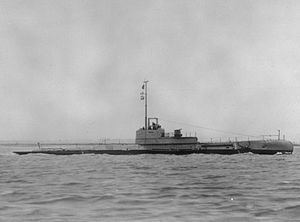Name HMS Sturgeon Laid down 1 January 1931 Recommissioned 17 November 1945 Launched 8 January 1932 Draft 3.2 m | Commissioned 15 December 1932 Construction started 1 January 1931 Length 62 m | |
 | ||
Renamed to Dutch Navy as Zeehond, 11 October 1943 | ||
HMS Sturgeon was an S-class submarine that entered service in 1932. The submarine saw service in the Second World War and in 1943 was transferred to the Royal Netherlands Navy as HNLMS Zeehond. Zeehond was returned to the Royal Navy following the war and was sold for scrap in 1946. She was one of the four submarines that formed the First Group of the S class, and the only one of these to survive the war.
Contents
Design and description
The S-class submarines were designed as successors to the L class and were intended to operate in the North and Baltic Seas. The submarines had a length of 202 feet 6 inches (61.7 m) overall, a beam of 24 feet (7.3 m) and a mean draft of 11 feet 11 inches (3.6 m). They displaced 730 long tons (740 t) on the surface and 927 long tons (942 t) submerged. The S-class submarines had a crew of 38 officers and ratings. They had a diving depth of 300 feet (91.4 m).
For surface running, the boats were powered by two 775-brake-horsepower (578 kW) diesel engines, each driving one propeller shaft. When submerged each propeller was driven by a 650-horsepower (485 kW) electric motor. They could reach 13.75 knots (25.47 km/h; 15.82 mph) on the surface and 10 knots (19 km/h; 12 mph) underwater. On the surface, the first-batch boats had a range of 3,700 nautical miles (6,900 km; 4,300 mi) at 10 knots (19 km/h; 12 mph) and 64 nmi (119 km; 74 mi) at 2 knots (3.7 km/h; 2.3 mph) submerged.
The boats were armed with six 21-inch torpedo tubes in the bow. They carried six reload torpedoes for a grand total of a dozen torpedoes. They were also armed with a 3-inch (76 mm) deck gun.
Construction and career
Sturgeon was built by HM Dockyard, Chatham. She was laid down on 1 January 1931 and launched on 8 January 1932. Sturgeon was commissioned on 15 December 1932.
At the onset of the Second World War, Sturgeon was a member of the 2nd Submarine Flotilla. From 23-26 August 1939, the 2nd Submarine Flotilla transferred to their war bases at Dundee and Blyth.
Sturgeon spent most of her career in the North Sea, off the Scandinavian coast. On 14 September 1939, she attacked her sister ship HMS Swordfish with three torpedoes but they all missed. This took place off the coast of Norway. Because of this incident, the Admiralty increased the operating distance of British submarines off Norway from 4 miles to 16 miles. She also attacked the German submarine U-23, but failed to hit her. Sturgeon claimed her first success when she sank the German anti submarine trawler V-209 (formerly Gauleiter Telshow) on 20 November 1939. The sinking of V-209 was the first successful attack on an enemy ship by a British submarine during the Second World War.
She went on to sink the German troop transport Pionier, the Danish merchant Sigrun, the Norwegian merchant Delfinus, and the German merchant Boltenhagen. She also fired six torpedoes against the German submarine U-43, but they all missed their target.
She was one of a number of submarines ordered to track the German battleship Bismarck before her eventual sinking.
HMS Sturgeon was then lent to the Royal Netherlands Navy from 11 October 1943 to 14 September 1945. During this time, she was renamed Zeehond.
HMS Sturgeon was returned to the Royal Navy after being lent to the Royal Netherlands Navy, and then broken up at Granton in January 1946.
